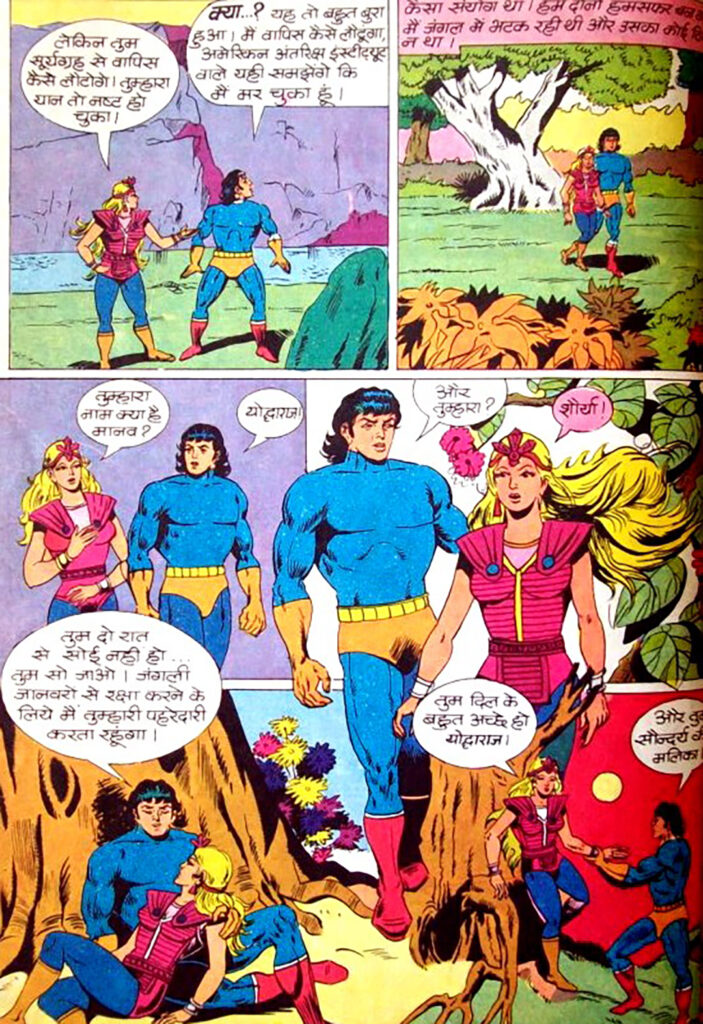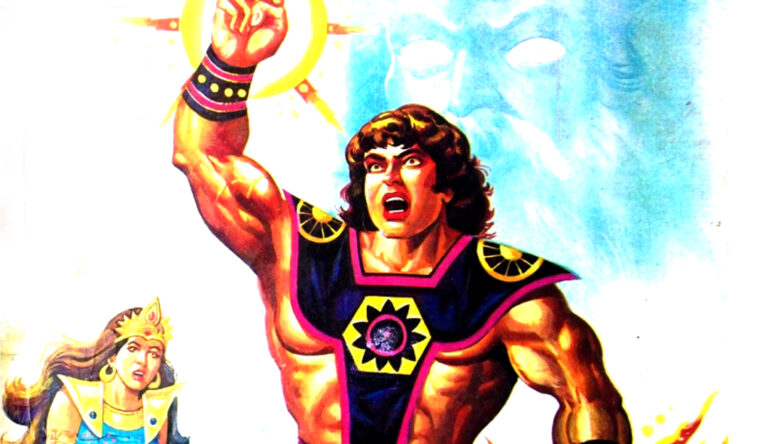Tulsi Comics, which gave many memorable heroes like ‘Angara’, ‘Jambu’, ‘Tausi’ and ‘Yosho’. The comics we are reviewing today is “Son of Fire”, published in Tulsi Comics Digest, which is the story of megastar ‘Yosho’. This work of writer Rituraj and painter Sanjay Shirodkar is a brilliant blend of science, mythology and fantasy, which was the special identity of the comics of that period.
Story and plot
“Son of Fire” begins on Earth. Michael, a young scientist at the American Space Institute, is telling an incredible anecdote to his superior, Sir Johnson. Michael has just returned from a mysterious planet called ‘Sunplanet’, which, being very close to the Sun, looks like a furnace of fire. Of the three spacecraft sent there in the last twenty years, only Michael’s spacecraft has returned safely.
Sir Johnson, who is a rationalist scientist, refuses to listen to his words. Then Michael tells that there lives a person named ‘Yosho’ on the Sun, from whose body fire comes out and bullets come out of his eyes. This very beginning fills the story with tremendous mystery and thrill.
The story then goes into flashback. Michael tells how he landed on the Sun and saw the sights there, where lush green trees and ice-cold water were present amidst the fire. This paradox makes the planet even more mysterious.

During his search, Michael sees a shocking scene: a young man (Yosho) is hanged on top of a fire, chained to a tree, and his mother is putting more logs into the fire. This scene is going to shake anyone.
Yosho asks his mother to intensify the fire, as he wants the fire to so deeply sink into his veins that he can create the fire himself whenever he wants. This is where we see the true form of Yosho—a hero who transforms pain and fire into his own strength. His body shines like hot gold and sparks start coming out of it. This is the root of his power, and that is why he is called the “Son of Fire”.
The story takes a dramatic turn when an unknown assailant attacks Yosho’s mother with a strange gun. Michael saves her by risking his life. In this chaos, Yosho breaks the chains with his immense power and defeats the flying attacker.
Next, Yosho’s mother (who is the former Empress of the Sun) tells her sad story to Michael. She says that her husband Yodwaraj actually came from Earth and Yosho is her son. Yosho is the real successor of the Sun. The Fire God has given special powers to Yosho so that he can take revenge on his father.
Because when Yosho was born, his father Yodwaraj left him and his mother and returned to Earth from Yan. When Yosho grew up and learned the truth, the fire burned in his mind to take revenge on his deceitful father.
Characterization
• Yosho:
Yosho is the perfect example of Indian comics heroes of that period. He has power, anger, a strong sense of justice, and a deep respect for his mother. His character symbolizes “fire”—which is both destructive and sacred. Driven by the fire of revenge, he walks, but his ultimate aim is not just vengeance but the establishment of justice and religion. His supernatural powers make him stand out from the crowd, while his dedication to his mother gives him human and emotional depth.
• Michael:
Michael can be said to be a representative of the reader in the story. He is an ordinary person who witnesses extraordinary events. The clash of his scientific thinking and Yosho’s amazing powers strikes a balance between reality and fantasy in the story. Not just the narrator, but he also plays the role of a true friend and helper, standing by Yosho every step of the way in his journey and mission.
• Yosho’s mother (Empress):
The Empress is a firm and strong female character. Despite being widowed and suffering exile from the kingdom, she raised her son like a warrior. Her deep faith and sacrifice are hidden behind taking such a drastic and unbearable step as hanging her son on fire. She knows that this same rigorous process will bring Yosho to his true potential. Her motherhood is not only a symbol of tenderness, but also represents sacrifice and rigorous discipline.
Artwork and portraiture
Indian comics have always been identified by their unique paintings. ‘Son of Fire’, painted by Sanjay Shirodkar, brilliantly sums up the traditional style of that period. Made with the use of four main colors—cyan, magenta, yellow and black—this comic gives a special ‘vintage look’, which still gives it a distinct identity today.
Shirodkar’s portraiture is dynamic and clear. Especially in action scenes, the movement, emotions and tension of the characters feel extremely alive. When the hero leaps on the enemy, the thrill of the moment spills out of the pages. Fluid torrents or flames emanating—scenes are carved in such a way that their effect reaches the reader directly.

The facial expressions of the characters are also highlighted in detail. Sir Johnson’s confusion and doubt, Michael’s confident smile, or the attacker’s cruel face—all are so accurately portrayed that the reader immediately connects with them. The panel layout is also simple but effective, allowing the flow of the story to move forward without any lag and keeping the reading experience smooth.
Although the depth and detailing of colors in this drawing may seem less compared to modern digital comics, this is its true beauty. It reflects the honesty of being made by hand. This rawness and simplicity makes it different and special from today’s highly sophisticated graphics.
Dialogue and Language
The language of this comic is Hindi, and this was one of the biggest specialties of that period. The dialogues are straightforward, simple and take the story forward. “Cory gossip!”, “Pulse!”—words like these not only add fun but also fill the story with energy and liveliness. This makes the reader feel as if he himself is present at the scene.
Dialogues are used in two main ways—one to provide information and the other to make the action more effective. The dialogues between Michael and Sir Johnson lay the foundation for the whole story, while the dialogues in the fight and confrontation scenes bring out the characters’ reactions and their emotions.
The best aspect of the language is that it is accessible to readers of all ages. It has no difficult vocabulary nor heavy sentences, but a simple dialect that makes instant connections.
Another interesting thing is that the expressions of the characters have also been highlighted very well through words. Like—”Michael was smiling.” This is not just a straightforward description, but also reflects his confidence and inner happiness. Such small details add depth and warmth to the story.
Conclusion
“Son of Fire” by Tulsi is among the finest productions of comics that even today seem as entertaining and relevant to read. The writer Rituraj’s tight script and Sanjay Shirodkar’s energetic portrayal combine to create an experience that takes the reader straight to a new and unique world. This comic is a brilliant confluence of science fiction, fantasy and Indian mythological elements, and that is its true strength.
For older readers it’s a nostalgia trip—a memory of those childhood days, when we used to get lost in the world of our own imagination for hours while reading comics. At the same time, this is a great opportunity for the new generation to understand how deep, imaginative and diverse the roots of Indian comics have been.
Yosho’s character conveys the message that adversity can be turned into opportunity. Inner “fire”—whether it is of anger, pain or passion—if used in the right direction, can defeat any challenge.
Overall, “Son of Fire” is a glorious chapter in Indian comics history, which every comics lover must read. It is not just a story, but a celebration of the thinking, art and imagination of that period.
